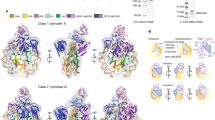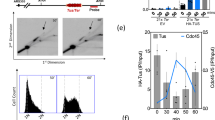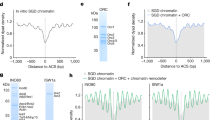Abstract
The packaging of the eukaryotic genome in chromatin presents barriers that restrict the access of enzymes that process DNA1,2. To overcome these barriers, cells possess a number of multi-protein, ATP-dependent chromatin remodelling complexes, each containing an ATPase subunit from the SNF2/SWI2 superfamily3,4. Chromatin remodelling complexes function by increasing nucleosome mobility and are clearly implicated in transcription5,6,7. Here we have analysed SNF2/SWI2- and ISWI-related proteins to identify remodelling complexes that potentially assist other DNA transactions. We purified a complex from Saccharomyces cerevisiae that contains the Ino80 ATPase8. The INO80 complex contains about 12 polypeptides including two proteins related to the bacterial RuvB DNA helicase9,10,11, which catalyses branch migration of Holliday junctions. The purified complex remodels chromatin, facilitates transcription in vitro and displays 3′ to 5′ DNA helicase activity. Mutants of ino80 show hypersensitivity to agents that cause DNA damage, in addition to defects in transcription8. These results indicate that chromatin remodelling driven by the Ino80 ATPase may be connected to transcription as well as DNA damage repair.
This is a preview of subscription content, access via your institution
Access options
Subscribe to this journal
Receive 51 print issues and online access
$199.00 per year
only $3.90 per issue
Buy this article
- Purchase on Springer Link
- Instant access to full article PDF
Prices may be subject to local taxes which are calculated during checkout





Similar content being viewed by others
References
Kornberg, R. D. & Lorch, Y. Twenty-five years of the nucleosome, fundamental particle of the eukaryote chromosome. Cell 98, 285–294 ( 1999).
Luger, K. & Richmond, T. J. DNA binding within the nucleosome core. Curr. Opin. Struct. Biol. 8, 33– 40 (1998).
Eisen, J. A., Sweder, K. S. & Hanawalt, P. C. Evolution of the SNF2 family of proteins: subfamilies with distinct sequences and functions. Nucleic Acids Res. 23, 2715–2723 (1995).
Peterson, C. L. Multiple SWItches to turn on chromatin? Curr. Opin. Genet. Dev. 6, 171–175 ( 1996).
Armstrong, J. A. & Emerson, B. M. Transcription of chromatin: these are complex times. Curr. Opin. Genet. Dev. 8, 165–172 ( 1998).
Kadonaga, J. T. Eukaryotic transcription: an interlaced network of transcription factors and chromatin-modifying machines. Cell 92, 307 –313 (1998).
Workman, J. L. & Kingston, R. E. Alteration of nucleosome structure as a mechanism of transcriptional regulation. Annu. Rev. Biochem. 67, 545–579 ( 1998).
Ebbert, R., Birkmann, A. & Schüller, H. J. The product of the SNF2/SWI2 paralogue INO80 of Saccharomyces cerevisiae required for efficient expression of various yeast structural genes is part of a high-molecular-weight protein complex. Mol. Microbiol. 32, 741– 751 (1999).
Qiu, X. B. et al. An eukaryotic RuvB-like protein (RUVBL1) essential for growth. J. Biol. Chem. 273, 27786– 27793 (1998).
Kanemaki, M. et al. Molecular cloning of a rat 49-kDa TBP-interacting protein (TIP49) that is highly homologous to the bacterial RuvB. Biochem. Biophys. Res. Commun. 235, 64–68 (1997).
Kanemaki, M. et al. TIP49b, a new RuvB-like DNA helicase, is included in a complex together with another RuvB-like DNA helicase, TIP49a. J. Biol. Chem. 274, 22437–22444 ( 1999).
Tsukiyama, T., Daniel, C., Tamkun, J. & Wu, C. ISWI, a member of the SWI2/SNF2 ATPase family, encodes the 140 kDa subunit of the nucleosome remodelling factor. Cell 83, 1021–1026 (1995).
Tsukiyama, T., Palmer, J., Landel, C. C., Shiloach, J. & Wu, C. Characterization of the imitation switch subfamily of ATP-dependent chromatin-remodelling factors in Saccharomyces cerevisiae. Genes Dev. 13, 686– 697 (1999).
Zhao, K. et al. Rapid and phosphoinositol-dependent binding of the SWI/SNF-like BAF complex to chromatin after T lymphocyte receptor signaling. Cell 95, 625–636 ( 1998).
Cairns, B. R., Erdjument-Bromage, H., Tempst, P., Winston, F. & Kornberg, R. D. Two actin-related proteins are shared functional components of the chromatin-remodelling complexes RSC and SWI/SNF. Mol. Cell 2, 639– 651 (1998).
Galarneau, L. et al. Multiple links between the NuA4 histone acetyltransferase complex and epigenetic control of transcription. Mol. Cell 5, 927–937 (2000).
West, S. C. Processing of recombination intermediates by the RuvABC proteins. Annu. Rev. Genet. 31, 213–244 (1997).
Wood, M. A., McMahon, S. B. & Cole, M. D. An ATPase/helicase complex is an essential cofactor for oncogenic transformation by c-Myc. Mol. Cell 5, 321–330 (2000).
Ikura, T. et al. Link of TIP60 histone acetylase to DNA repair and apoptosis. Nature (submitted).
Côté, J., Quinn, J., Workman, J. L. & Peterson, C. L. Stimulation of GAL4 derivative binding to nucleosomal DNA by the yeast SWI/SNF complex. Science 265, 53– 60 (1994).
Cairns, B. R. et al. RSC, an essential, abundant chromatin-remodelling complex. Cell 87, 1249–1260 (1996).
Mizuguchi, G., Tsukiyama, T., Wisniewski, J. & Wu, C. Role of nucleosome remodelling factor NURF in transcriptional activation of chromatin. Mol. Cell 1, 141–150 (1997).
Weinert, T. A. & Hartwell, L. H. Characterization of RAD9 of Saccharomyces cerevisiae and evidence that its function acts posttranslationally in cell cycle arrest after DNA damage. Mol. Cell. Biol. 10, 6554–6564 (1990).
Huang, M. & Elledge, S. J. Identification of RNR4, encoding a second essential small subunit of ribonucleotide reductase in Saccharomyces cerevisiae. Mol. Cell. Biol. 17, 6105 –6113 (1997).
Haber, J. E. DNA recombination: the replication connection. Trends Biochem. Sci. 24, 271–275 ( 1999).
Seigneur, M., Bidnenko, V., Ehrlich, S. D. & Michel, B. RuvAB acts at arrested replication forks. Cell 95, 419–430 (1998).
Gdula, D. A., Sandaltzopoulos, R., Tsukiyama, T., Ossipow, V. & Wu, C. Inorganic pyrophosphatase is a component of the Drosophila nucleosome remodelling factor complex. Genes Dev. 12, 3206–3216 (1998).
Hansen, S. K. & Tjian, R. TAFs and TFIIA mediate differential utilization of the tandem Adh promoters. Cell 82, 565–575 (1995).
Tsukiyama, T. & Wu, C. Purification and properties of an ATP-dependent nucleosome remodelling factor. Cell 83, 1011–1020 (1995).
Park, J. S., Choi, E., Lee, S. H., Lee, C. & Seo, Y. S. A DNA helicase from Schizosaccharomyces pombe stimulated by single-stranded DNA-binding protein at low ATP concentration. J. Biol. Chem. 272, 18910–18919 (1997).
Acknowledgements
We thank T. Tsukiyama and the CSHL yeast genetics course 1998 for expert training, and members of our lab for help and discussion. We also thank Y. Nakatani, J. Pradel and J. Cote for sharing results; W. S. Lane for peptide sequencing; F. Winston and D. E. Gottschling for yeast strains; and M. Lichten and G. Storz for helpful comments on the manuscript. X.S. was supported by the American Cancer Society, and A.H. was supported by the Human Frontiers of Science Program. This work was supported by the Intramural Research Program of the National Cancer Institute.
Author information
Authors and Affiliations
Supplementary information
Rights and permissions
About this article
Cite this article
Shen, X., Mizuguchi, G., Hamiche, A. et al. A chromatin remodelling complex involved in transcription and DNA processing. Nature 406, 541–544 (2000). https://doi.org/10.1038/35020123
Received:
Accepted:
Published:
Issue Date:
DOI: https://doi.org/10.1038/35020123
This article is cited by
-
Thermodynamics, optical properties, and coordination of lanthanoids with hydroxyquinolate functionalised receptor
Journal of Inclusion Phenomena and Macrocyclic Chemistry (2024)
-
Adaptive partitioning of a gene locus to the nuclear envelope in Saccharomyces cerevisiae is driven by polymer-polymer phase separation
Nature Communications (2023)
-
Colorimetric Detection of ATP by a Chlorophosphonazo III -based Mg2+ Complex in Aqueous Solution via Indicator Displacement Approach
Journal of Fluorescence (2023)
-
WASHC1 interacts with MCM2-7 complex to promote cell survival under replication stress
Molecular Biology Reports (2022)
-
Comparative interactome analysis of the PRE DNA-binding factors: purification of the Combgap-, Zeste-, Psq-, and Adf1-associated proteins
Cellular and Molecular Life Sciences (2022)
Comments
By submitting a comment you agree to abide by our Terms and Community Guidelines. If you find something abusive or that does not comply with our terms or guidelines please flag it as inappropriate.



